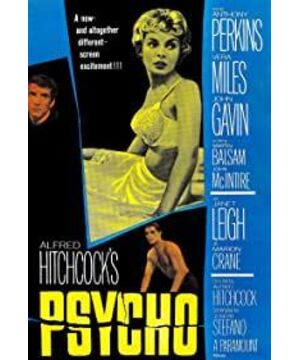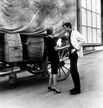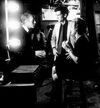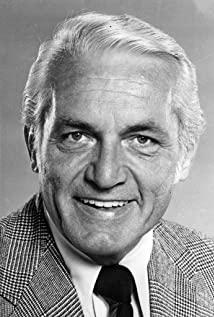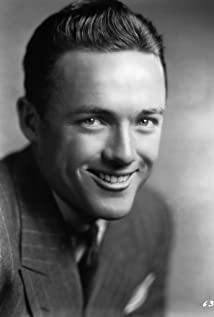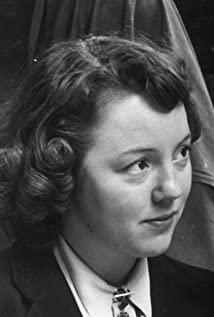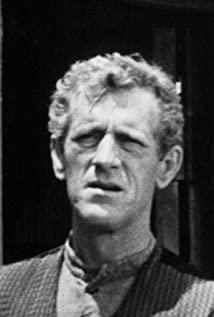1. About the director: the art world of the master of suspense [2]
Hitchcock is a unique director. He is a British national who moved to the United States on the eve of the outbreak of World War II in 1939 and spent the peak of his career in the United States. In 1980, a few months before Hitchcock's death, the Queen of England awarded him the knighthood. He has made more than 50 movies in his life, most of which are suspense or thrillers, because he thinks this kind of subject matter is the most attractive. He has never won an Oscar for best director, he doesn't like to make a fuss about academics, and he has never been a teacher, but almost all contemporary filmmakers regard him as a mentor; because he has almost tried all the shooting techniques often used in contemporary movies. , Has carried out various explorations on film art. He is called "the treasure chest of film skills". The films he directed do not contain profound truths like European art films, so he has long been regarded by American critics as a craftsman and an ordinary commercial film director. But the Europeans discovered his value. With the rise of the new wave of French cinema in the 1960s, the "author theory" in film theory dominated the film theory. Critics of the "Cinema Manual" led a reversal of the evaluation of film directors. Hitchcock has recently received Leading among respected "movie authors". [3] In 1965, the famous French New Wave director and film critic Truffau traveled a long distance to Hollywood, USA, and conducted a special interview with Hitchcock, and organized the conversation between the two into a book, titled It's called "Hitchcock on Movies." Truffaut’s insightful questions and Hitchcock’s unreserved answers reveal a lot of Hitchcock’s film experience and skills, making this book a rare textbook for film professionals and film lovers. Since then, Hitchcock's status as a master of film art has gradually been widely recognized.
Today, among film professionals, Hitchcock is a recognized master. But for many film lovers, whether Hitchcock is an artist and whether his films are "art films" still often cause confusion, because his films are too much like Hollywood entertainment films. In this regard, Truffaut said for a while. He first praised Hitchcock’s extraordinary ability to control all film elements, and then said: "It is precisely because Hitchcock can control all the constituent elements of a film, that is, to personally The idea runs through all stages of filming. Therefore, his films do have a unified style. Everyone recognizes that he is one of the rare three or four directors in the world. No matter which of their films, just watch In a few minutes, you will recognize it." [4] It is precisely because of the distinctive personal style of Hitchcock's films that he was classified as a great film author by New Wave film critics who insist on "authorism".
For those who like to watch movies, the five late Hitchcock films are must-sees: "Rear Window" (1954), "Vertigo" (1958), "Northwest by North" (1959), "Cry of Souls" "(1960), "Flock of Birds" (1963). If you want to really understand Hitchcock, you still need to read his early works, such as "Butterfly Dream", "Doctor Edward" and so on.
In the remainder of this article, the author will use "Scary" as an example to make a simple analysis of the characteristics of Hitchcock's suspense film.
2. Analysis of the play: How is the suspense story weaved
? "The First Book" and the First Suspense
There is a simple rule for movie dramas, which is to write the "first book" well. The quantifier "ben" refers to the paragraphs that can be captured by the camera with a roll of film, about 10 minutes. Therefore, the so-called writing the first book is to write the plot of the first ten minutes. For a playwright, the first 10 minutes of the play can already determine whether the director or producer will adopt his script, whether the audience wants to watch the film, and whether he can quickly enter the context of the film. So it is very important to write the first book well. For commercial films, try to attract audiences with unique plots in the first 10 minutes; for art films, try to infect audiences with unique artistic charm in the first 10 minutes. For suspense movies, the requirement to write the first book is to throw the first small suspense, or the first small climax, in the first 10 minutes. The drama of "The Cry" basically meets this requirement. The first suspense appeared in about 10 minutes and 40 seconds, that is, the heroine Marianne escaped with the money. From then on, the audience began to care about whether Marianne would be caught, and thus entered the scene of the movie.
2. Experimentation of the structure of the play: The structure of the play that diverts the audience's attention
is unique in Hitchcock's films.
The structure of Hitchcock's film dramas can be basically divided into two categories: one is the wave that rises above another, and the other is that the wave is not smoothed and the wave is rising again. The former refers to a big suspense dominating the whole film. During the cracking of the suspense, the plot continues to develop, and finally there is a climax, and the suspense is resolved. There are many examples like this. The latter means that one suspense has not been resolved, and another suspense is generated. Many suspenses are intertwined, and these are resolved in turn or at the climax during the development of the plot. Thrill films often adopt this structure, such as "Northwest by Northwest".
"Scary" basically belongs to the former type, and the suspense of "Who killed Marianne" dominates the film. But its particularity lies in the fact that in the first 45 minutes of the film, the audience was attracted by another suspense: Will Marianne, who ran away with the money, be caught. When this suspense was about to be resolved (Marian decided to return to Phoenix the next day), the heroine was suddenly killed, the plot took a turn for the worse, and the main suspense appeared. The advantage of this arrangement is that the first 45 minutes of the plot diverts the audience's attention, and the audience will be more shocked when they see Marian being killed. In order to effectively achieve this goal, Hitchcock also arranged for the police to follow Marianne and change the car, and constantly emphasized the 40,000 dollars in the paper bag, all of which are to ensure that the audience will not guess the following plot. Hitchcock is very happy to play such psychological games with the audience. He said: "The structure of the film is extremely interesting, and it contains experiments that I want to play with the audience with great interest. In "Psychopath" ( That is, in "The Terror"-the author's note, I control the audience's attention all the time, and I am as powerful as I play the organ." [5]
In addition, Hitchcock let the heroine be in the first third It takes courage to die more often. Hollywood film production implements a star system, and the entire goal of a film is often to make a star beautiful and brilliant. The female celebrity that made the audience's attention disappeared in the first third, it may be difficult for other directors to do so.
3. The plot setting has to be "one twists and turns"
Suspense movies must always attract the attention of the audience, and the twists and turns of the plot are very important. The word "twists and turns" is easy to say, but what should I do? When Hitchcock explained "what is suspense", he gave an example: three people were sitting on a chair and chatting. There was a time bomb under the chair and it exploded after 5 minutes. How to shoot this story? In the first method, only three people were chatting, and there was no explanation of the bomb. The bomb exploded 5 minutes later. The audience was shocked only at the moment of the explosion, and there was no tension at other times. In the second shooting method, first tell the audience that there is a bomb. The audience will feel anxious at first, but their patience is limited. Since they know that the bomb will explode sooner or later, they will lose interest after a while. Hitchcock uses the third method of shooting. First tell the audience that there is a bomb, and then shoot three people sitting in chairs and chatting; after talking for 3 minutes, one person says let’s go. At this time the audience is particularly happy, but the other two people If you say no, you have to talk for a while; after another minute, two people said they were leaving, the audience said in their hearts that you should go quickly, and the third person said to wait a while; for the remaining minute, regardless of whether the bomb exploded or not. Can attract the attention of the audience. [6] This method of shooting has achieved twists and turns.
The plot of "Scary" fits this feature. When the private detective Abel Gates was killed at Bates's house, Marian's sister Layla couldn't wait for Abel Gates to return, and insisted on going to Bates's house to check the situation. At this time, the audience already knows that going to Bates's house is dangerous, and Laila is a weak woman, they will say in their hearts that Laila must not go. Marianne's boyfriend Sam persuaded Laila, went to Bates's house by herself, leaving Laila behind. The audience breathed a sigh of relief, but they were still worried about Sam's safety. Sam finally returned safely and decided to go to the police. The audience thought that there was no problem at all, and the police should be able to solve the problem. However, the police were unwilling to pursue the investigation and revealed that Bates' mother had passed away ten years ago. At this time things are more confusing, and Laila insists on going to Bates's house again, which makes the audience even more worried about her. Fortunately, Laila and Sam went together this time. It's better than Laila going alone. When the two of them inspected the hotel room where Marianne had stayed, they decided that Sam would stay in the hotel to stabilize Norman. Laila went to the Bates house to talk to Norman’s mother because they thought Norman’s mother. Just a weak old lady, Laila can handle it. But the audience knows that Norman's "mother" is actually the most dangerous, so the tension reached its highest point at this time, the climax is ready to come out, and the audience will inevitably focus all their attention on the moment when the truth is revealed. Throughout the process, there is always some information that the audience knows but the characters in the play do not know, and the audience will worry about the characters in the play. This kind of plot setting is indeed twists and turns, and every moment can firmly grasp the audience's attention.
3. Audiovisual analysis: How is the atmosphere of suspense created? [7]
1. The beginning of the opening
film is a big vision of Phoenix, explaining the environment where the story takes place; at the same time subtitles are played: Arizona, Phoenix, Friday, December 11, 2:43 pm. Hitchcock said that he did not like to use subtitles in this way. He prefers to use images to explain locations, such as using the Eiffel Tower to imply Paris and Big Ben to imply London. However, he thinks it is necessary to use subtitles to indicate the time of 2:43 pm here, because it can emphasize that the heroine Marianne and her boyfriend Sam sacrificed lunch time to come to the hotel for a tryst. [8] We will know soon that they came here because they have no money to get married. This paved the way for Marianne to escape with the money.
The camera scene diminished, and finally fell into a hotel window. This kind of opening method is commonly used in Hollywood movies: first use the big scene (usually the big perspective) to explain the environment of the story, and then push it into a small scene, or cut into a small scene, until the camera is aimed at the main character. The difference in this film is that Hitchcock lets the lens advance directly from the window, so the audience becomes a peeper lying on the window. Movie audiences are peepers, which is also a proposition that Hitchcock likes to express in films such as "Rear Window".
2. From Marian's escape to her escape from Marian to before she was killed
, the director's general goal is to divert the audience's attention, and all audiovisual elements serve this point.
In Marian's house, the scene of preparation before escape was performed in an extremely concise way. The first shot: Marianne is in the picture from the left, the middle shot, and his eyes are looking towards the lens; the lens is shaken and pushed to a close-up of the 40,000 dollars (in a paper bag) placed on the bed; then the lens is shaken and pulled to the left, Become a close-up of a travel suitcase on the bed. This shot has a total of 20 seconds and is a montage within the shot. Without any dialogue, the focused audience can judge Marianne's next move from just this shot. This kind of concise and clear narrative ability is very powerful. In the following shots, through Marianne’s gaze from time to time and 4 close-ups of the money, the constant emphasis on the money in the paper bag shows Marianne’s uneasy mood and also allows the audience to focus on 40,000. Above the dollar.
After that, arrangements were made for a sudden encounter with the boss, police tracking, Marianne's change of car, and intense music, all in order to attract the audience's attention to whether Marianne could escape successfully.
It is worth noting that when Marianne left the used car market and went on the road again, we heard the dialogue between the police and used car market staff, the boss and Marianne colleagues, the boss and the customer, but the scene did not cut to the scene of their conversation. , But always aimed at Marian, showing her anxious expression with close-up shots and close-ups of Marian. This is because the director believes that the audience is most concerned about Marianne's situation at this time. Although other things are necessary, there is no need to waste time. Here, the director uses the counterpoint relationship between sound and picture to save the picture and avoid distracting the audience.
In the wind and rain, Marianne came to Bates’s hotel, met Norman who came out to greet her, and for the first time saw the shadow of the old lady in the windows of Bates’s house. We can find that the house and hotel of Bates’s house, as the main scene of the film, were carefully selected. First of all, the house and the hotel are at right angles. The horizontal hotel and the vertical house constitute the main composition of the film. On the one hand, it avoids the monotony of the composition. On the other hand, it forms an effect: Marianne looks from the window or door of the hotel. Looking out, you can always see the mysterious house of the Bates family in the dark, which makes this house a shadow over Marian and the audience. Secondly, the house is much taller than the hotel, and the shots of the house taken from the direction of the hotel are all from upside down, making it even taller. Tall, enclosed buildings often give people a gloomy and depressing feeling. The castle in Kafka's novel "The Castle" is such an image. The house of Ribetz's house in this film gives people the same feeling. At the same time, at the end of the film, Marianne's sister Laila has to walk up a high level to enter the house, which lengthens the time Laila is close to the house and creates tension in the audience.
When Marianne walked into Norman's management room at the hotel, she saw the corner of the wall was covered with owl specimens stuffed with straw. This Tao is very symbolic. Owls are nocturnal birds. They always watch everything around them vigilantly, much like Norman's closed, guilty mind. At the same time, this also echoes the body of Norman's mother stuffed with straw that appeared later.
Marianne and Norman had a conversation in the management room. This conversation was basically handled in the usual Hollywood way: fight forwards and backwards, and don't cross the line. But the scene is changing, from mid-range to close-up and close-up. The scenes gradually became smaller, and their expressions became clearer and clearer, indicating that the conversation between the two became deeper and deeper. This also indicated that Norman became more and more interested in Marianne, which paved the way for him to spy on Marianne later.
At the end of this passage, the camera enters the Bates house for the first time, but only stays under the stairs.
3. The
scene of Marianne's murder "Bathroom Murder" is the most famous passage in "The Cry". It has become a classic in film history, and it is necessary to analyze it separately.
In the "Murder in the Bathroom" scene, from Marianne writing the calculations in the bedroom to Norman's "mother" running back to the house, a total of 4 minutes, the director used more than 60 shots. Counting from the shot where Norman "mother" appeared, it was only 1 minute and 40 seconds and 44 shots were used. On average, each shot was only a little more than 1 second, and some shots were less than 1 second, with only a few frames. This is a montage of moving clouds and flowing water, achieving the effect of giving the audience a double illusion.
First of all, the horror atmosphere of murder in the bathroom is produced by the murder, and the audience must be convinced that the murder process on the screen is real. But in the actual shooting process, the killing is fake. How to make the audience believe it is an important issue. At the beginning, the crew prepared a half-length mannequin for Hitchcock, which contained a blood sac, and blood would gush out when the knife was stabbed; but Hitchcock was unwilling to use this model. Hitchcock, who has strict requirements for authenticity, prefers to use real people. Of course, Janet Lee, who played the heroine in some nude scenes, was reluctant to act, so a female stuntman was used. But even if you use a stuntman, you can't really kill the actor. Of course, many kinds of special effects can be used to shoot murder scenes, but Hitchcock does it entirely by montage. In fact, the knife did not touch the actor's body at all. The director let us see mostly close-ups and close-ups of the actor's head, hands, abdomen, and knife. These isolated close-ups and close-ups were quickly combined to produce the effect. The audience was convinced that the knife stabbed the heroine's body, creating an incredible atmosphere of horror.
Then, there is another question, how to avoid the restricted area of the actress's body from being painted in this nude and intense sports scene. For example, how to avoid breast painting is a very realistic and difficult problem. It is common for actresses to have breasts exposed in movies today, but in the 1960s, the strict film censorship regulations "Hays Code" are still in effect, and actresses' breasts are not allowed to be exposed. To solve this problem, many shots shoot slow motion or even close to still images. In post-production, these shots are not accelerated, but they are inserted directly into the montage of quick assembly. Since these shots are short and the assembly is fast, the audience will think that the actors are in intense movement at this time. Film censorship laws originally restricted the director's creation, but here they have prompted Hitchcock to be creative and play the role of a beast.
The knife did not touch the actress's body, but the audience felt it had been pierced in. The role of the montage here was to create an illusion of space; the director originally shot slow motion, but the audience felt that the actors were in intense motion. The role of the montage here is Create the illusion of time or speed. Hitchcock gives full play to the function of montage, so that the audience has a double illusion.
In addition, the horror atmosphere also comes from a styling factor, that is, the shape of Norman's "mother" holding up the knife. Although not necessarily in line with the actual killing posture, it is indeed effective for creating a terrifying atmosphere. In order to avoid revealing the true face of the murderer, the director treated Norman's "mother" as a dark shadow. I am afraid that the use of light does not meet the overall lighting conditions of the bathroom, but the audience is extremely frightened and can't manage so much.
Hitchcock’s progress in shooting the entire film is very fast, but it took 7 days to shoot this scene. [9] This also shows that the filming of this segment is very difficult and the director has put a lot of effort.
4. The detective's investigation and the murdered
private detective Yabo Gates is a transitional figure. His investigation helped Laila and Sam focus on Bates's house, but did not reveal the truth. And his death strengthened the atmosphere of terror. The scenes before and after the detective was killed are also carefully designed and arranged.
In the scene where Yabo Gates asked Norman in the hotel, we felt that there was a big contrast between the dialogue between the two people and their inner activities. We can see Norman's sometimes pretentiously relaxed and sometimes embarrassed expressions. In contact with the previous plot, we can also imagine that he is trying to conceal his guilt. In short, it is far from what his dialogue shows as nonchalant. Yabo Gates looks alert and sophisticated, and speaks politely and calmly, but we can imagine that he is trying to capture the contradictions and loopholes in Norman's words. The detective's performance made us feel relieved and made us feel even more surprised when he was killed. Here, the relationship between the sound and the picture is originally a synchronous relationship, but due to the great contrast between the dialogue and the psychological activities of the characters, Truffaut also calls this relationship a counterpoint relationship, and believes that this counterpoint relationship is a rare issue. An important feature of Kirk’s films: "In order to obtain purely visual theatrical effects in each of his films, to a large extent, they are based on the principle of contrast between the picture and the dialogue, so that the first situation can be shown at the same time. (Obvious) and the second situation (hidden)."[10] Such a relationship between sound and picture has also become a means of constructing suspense: the audience will ask in their hearts, what lies will Norman tell? Can Norman's lies fool the detective? These have become suspense that attracts the audience.
The scene where Yabo Gates was killed at Bates's house is also one of the most frightening passages in the film. When Yabo Gates reached the top of the stairs, the camera was originally shooting along an angle parallel to the stairs, and suddenly cut into a vertical downwards overhead shot. Hitchcock explained the reasons for this: First, if the original angle is maintained, when Norman "mother" appears, only her back can be photographed, and the audience will ask: why the director deliberately prevents us from watching her Where's the face? And when you shoot down from the highest point, you can take Norman "Mother" Although she still can't see her face in her whole body, the audience will feel that she just happened to not see her face, not that the director deliberately didn't take her face. Second, the panoramic view from this overhead is in sharp contrast with the close-up shot of Yabo Gates below, making the connection between the shots not monotonous. The shot that Yabo Gates fell down after being stabbed used a simple but often used stunt by Hitchcock: first go down the stairs with a mobile camera and take an empty shot; then go back to the studio and let The actor acting as a detective sits on a special chair, and the transparent background behind it shows the shots just taken. The staff helps to shake the chair. The actor only needs to make some gestures on the chair to show his arms waving wildly. [11] This was a shot of the detective falling back down the stairs.
Norman took the "Mother" down the stairs and also used a vertical downward shot, the purpose is still to prevent the audience from seeing the true face of "Mother" without making the audience question. When Norman walked up the stairs, the camera was raised and came to the door of his mother's bedroom. Then he continued to raise it, rotating and aiming straight down at the top of the stairs, waiting for Norman to hold his "mother" out of the bedroom and down the stairs. In order to prevent the audience from paying attention to the complex movement of the camera, the quarrel of "mother and son" is heard while the camera is moving. The audience will pay attention to the dialogue and ignore the change of the camera's shooting angle. In explaining this, Hitchcock said: "For me, how to use the camera to pose a ecstasy to the audience is a lot of fun." [12]
In this large paragraph, the light on Norman has changed. . Prior to this, Norman’s light was adequate, and we could clearly see his handsome and slightly feminine face. In this paragraph, Detective Yabo Gates asked about Norman’s departure, and when Sam went outside Bates’s house to look for Yabo Gates, he inserted Norman’s mid-range lens twice: once with side light and half of his face. Hidden in the dark; the other time it was backlit, and the front of the face was covered by darkness. This implies that Norman's face is vague, and there is a big secret hidden in his body.
In this segment, the camera first reached the stairs of Bates's house, but did not enter the mother's or Norman's bedroom.
5. The truth is
revealed. When Sam and Laila came to the Bates house together, the Bates house was exposed to the sun for the first time. Before this tall house was always shrouded in the night, or under the ambiguous evening light. At this time, the day's light conditions will show that the truth is about to come.
When Laila approached the house of Bates’s house, the high steps played a role: it lengthened the time Laila approached the house and increased the tension of the audience. This is because we all have this experience: when we know that something dangerous is coming, the waiting period is often the most stressful. In order to exaggerate the tension, the director used several slightly shaking in-depth shots to express Laila's subjective viewpoint, and inserted Laila's close-up shots and close-ups. At this time, we felt the slight shaking of the lens like Laila's heartbeat. This technique is also used in other Hitchcock films, such as the heroine walking up the stairs in the attic in "The Birds". This technique is often used in contemporary thrillers and police films, such as David Lynch’s "Muholland Road" and Luc Besson’s "Killer Leon" where the girl enters the police station. A scene in the men's room.
After entering the Bates house, Laila used a set of cross montages, and the camera switched several times between the Bates house and the hotel. As Laila approached the basement step by step, the conversation between Sam and Norman also broke out, and the tension in the two scenes increased at the same time. When Sam was knocked down by Norman, Norman ran to the house and Laila entered the basement, the two clues merged into one, and the climax of the whole film arrived. The editing method of cross-montage began in Griffith, and was carried forward by directors such as Hitchcock. Today, it has become the standard method for culpability of cop and thriller films.
In this part, the camera enters the most secret part of the Bates house-Norman's mother's bedroom, Norman's bedroom, and basement, which means that the truth will finally be revealed.
After the psychiatrist explained Norman's mental state, the camera followed the policeman who sent the blanket into the corridor and cut into the interrogation room. We saw Norman's frontal middle shot and then pushed it into a close shot. At the end of the film, the director also asked the lingering audience to directly face Norman again, facing his split and crazy mind, so as to draw a successful conclusion to the entire film filled with horror.
4. Cultural Studies: Gender and Psychoanalysis
For film works, in addition to analyzing the film itself, it can also be interpreted from a variety of perspectives, such as culture, ideology, and so on. Here, two aspects will be briefly mentioned for the film "The Cry": gender and psychoanalysis.
Regarding a scene where Marianne and Sam had a tryst at the beginning of the film, Truffaut quoted another French film critic and joked to Hitchcock: the heroine Marianne only wore a bra and night skirt, while her boyfriend Sam had only the upper body naked. , The lower part of the body is neatly dressed in pants, so the beginning of this film can only make half of the audience happy. [13] Although Truffaut’s words are mostly a joke, they do reflect a long-standing reality in American movies, which is that the audience of movies is assumed to be male; therefore, the female body needs to be shown on the screen as the object of male viewing. And the male body does not have to show, because the female desire does not need to be considered. Of course, this is not a problem with a film of "The Cry", but a phenomenon that has long existed in American movies. It is a reflection of a male-dominated consumer society in the film. The environment is nothing more. This phenomenon has of course been constantly criticized by modern feminists.
The relationship between Norman and his mother in "The Cry" is an example of a typical Oedipus complex. "Oedipus complex" was proposed by Freud, and this concept was already proposed in Freud's famous work "Interpretation of Dreams" (or translated "Analysis of Dreams") in 1900. Freud proposed the concept of Oedipus complex when expounding the materials and sources of dreams. He analyzed the ancient Greek tragedy poet Sophocles’ Oedipus King and Shakespeare’s Hamlet, and then pointed out: "The destiny of all of us may be directed towards our mother. , And directed the initial hatred and primitive desire to kill against his father.... However, we are luckier than him, because we have not become neurotics, and we have successfully got rid of the sexual impulse towards our mother. , And at the same time forgot the jealousy of his father." [14] Obviously, Norman became a mentally ill patient because he did not forget the love for his mother and the jealousy of his father like ordinary people. He would not suppress his original desires like ordinary people, so he would kill his mother and his mother's lover, and later became schizophrenic because of a heavy sense of guilt. The killing of Marianne by the "mother" attached to Norman also reminds us that on the other side of the son's obsession with the mother, the mother will also be jealous of the woman who approaches the son. In Hitchcock's other films, there is also such a relationship between characters. The relationship between the protagonist of "The Birds" and his mother obviously has the same tendency. Moreover, the Oedipus complex of the characters in the two films has been strengthened for the same reason: the loss of his father in his early years. Hitchcock was the first to introduce Freud's psychoanalysis into the film. Hitchcock is so interested in psychoanalysis, I think there may be two reasons: first, Hitchcock likes to use movies to show unusual people and things, and the situation shown by psychoanalysis meets this requirement; The second is that Hitchcock believes that the director should study the psychology of the audience and that the director should become a half psychologist, so he has a special interest in psychology.
5. Remaining Discussion: Investment and Income
Hitchcock is not only the director of "The Cry", but also the producer. He was successful artistically as a director, and commercially successful as a producer. "Scary" only cost 800,000 US dollars, but the revenue reached 13 million US dollars. In order to save money, Hitchcock used only one TV crew for filming, and most of the time the filming was completed in accordance with the filming schedule of the TV series. He said he wanted to do an experiment: "Can I make a large-scale feature film under conditions like making a TV film?" [15] In the case of small investment and fast progress, he can achieve great success, and of course he is hopeful. Ou Kirk's superb artistic level also gives us an inspiration: whether a film is commercially successful does not necessarily depend on the scale of investment and production. Nowadays, some of our Chinese directors are pursuing big productions and big scenes like Hollywood, but the works they produce still have serious flaws. Such films cannot continue to attract audiences and promote the sound development of the film industry. Hitchcock’s experiment tells us that the important thing is not to pursue the scale of production, but to actually improve the production level, so as to truly win the recognition of the audience.
Notes:
[1] The English film title of "Scary Soul" is Psycho, and the Chinese film title is also translated as "Mentally Ill" or "Psychopath".
[2] This part of the overview of Hitchcock's life refers to the director's introduction part in "Film about Movies-Analysis of "Rear Window"" by Zheng Dongtian (see Zhang Huijun, Chen Xi, Wang Honghai editors: "Film Analysis Perspective" Manual", China Film Press, September 2003, pages 193~194), and many unsigned articles on the Internet.
[3] Regarding the director’s review of the rise of the new wave of French cinema, see Jiao Xiongping: "The New Wave of French Cinema", Jiangsu Education Publishing House, May 2005, pages 65-69.
[4] François Truffaut, translated by Yan Min: "Hitchcock on Film", Shanghai Literature and Art Publishing House, August 1988, p.16.
[5] Ibid., p.280.
[6] Regarding this example, the author only found a simplified version in "Hitchcock on Movies" (see page 51~52 of the above quotation). The version quoted here is quoted from Zheng Dongtian: "Movies About Movies" - "Analysis of the Rear Window" (see Editors: Zhang Huijun, Chen Xi, and Wang Honghai: "Film Analysis Perspective Manual", China Film Publishing House, September 2003, page 196).
[7] Many places in this part refer to François Truffaut, translated by Yan Min: "Hitchcock on Movies", Shanghai Literature and Art Publishing House, August 1988, pages 275-296, except for some specific quotations And the specific facts are no longer marked.
[8] Ibid., p.276.
[9] Ibid., p. 286.
[10] Ibid., p. 14.
[11] Ibid., pages 283~284.
[12] Ibid., p.286.
[13] Ibid., p. 277.
[14] Freud: "Interpretation of Dreams", The Commercial Press, December 2003, p. 262.
[15] François Truffaut, translated by Yan Min: "Hitchcock on Film", Shanghai Literature and Art Publishing House, August 1988, p.295.
http://blog.sina.com.cn/u/55afbad00100071b
View more about Psycho reviews


